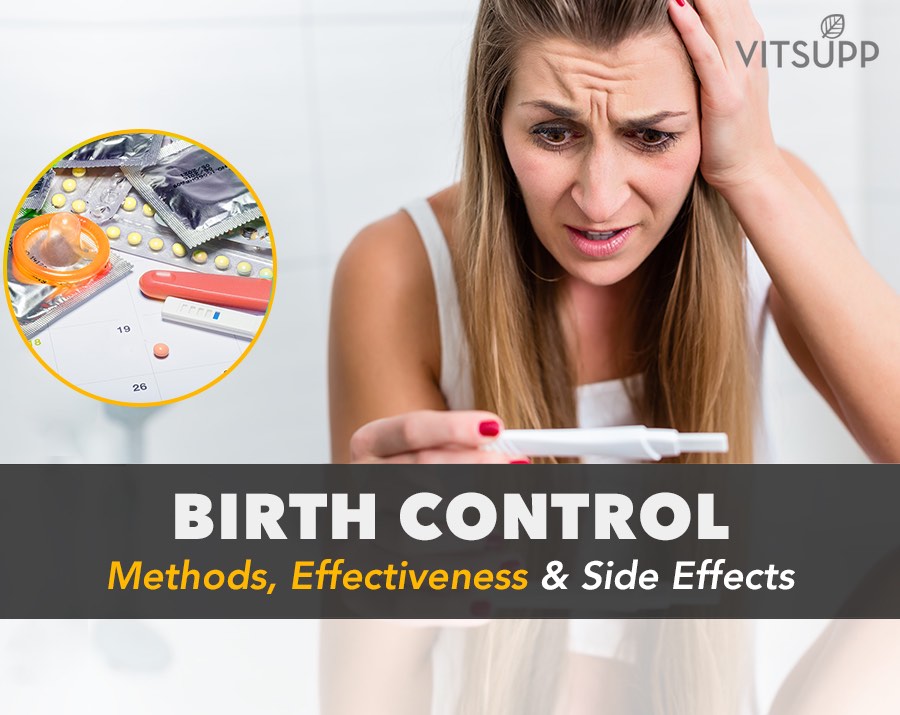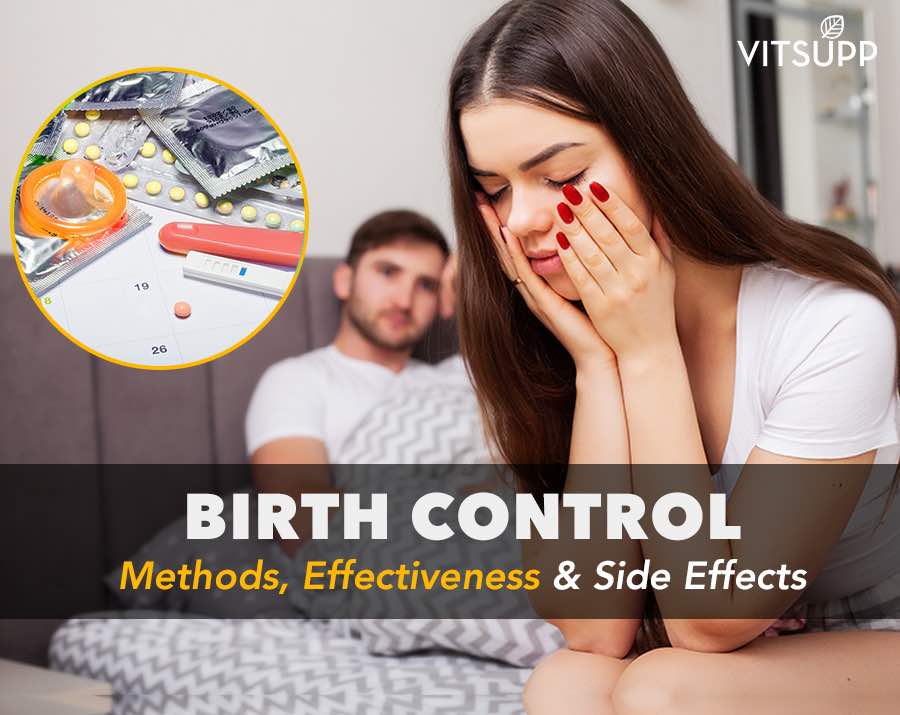Birth control is a crucial public health issue and millions of men and women worldwide depend on it. Birth control tools and pills available today are safe, dependable and inexpensive- but do you know enough about them to take the right decision for yourself?
Almost every woman today has thought about going on birth control, but most of them don’t have enough information on the topic. In this article, we are going to talk at length about this very important issue, and provide all the information you need to know about birth control.
But before discussing this, let us understand what exactly we mean by birth control.
Contents
What is Birth Control?
Birth control is the practice of preventing unplanned pregnancy with the use of contraception. It can be done through various medically proven methods, medicines or devices. Some methods work on women while some are specifically made for men’s usage.
All methods of birth control have their own degree of effectiveness, sustaining duration and side effects according to their nature. Women need to understand each method, compare them and only then they should decide which method will work best for her.
Most Popular Birth Control Methods in India

Methods you select can vary according to various factors like prevention from Sexually Transmitted Infections (STIs) or hormonal birth control. If you just want to avoid pregnancy then you can go for pills but if you want to protect yourself from STI- including AIDS- you need to use a condom.
Types of birth control methods
Here are 17 types of birth control methods prevalent all around the world:
- Birth control pills-these are hormonal pills which women need to take daily at the same time. Packet may contain some placebo pills which are taken during hormonal pill free days. [4]
- Condom-condoms are thin rubber sheets worn by men on their penises while having sex. It is the only method to be protected from STDs and is distributed for free by the Ministry of Health and Family Welfare. (3)
- Femidom or Female condom- female condoms belong to the barrier method of contraception. They are made of thin rubber sheet with dual protection. (4)
- Contraceptive patch-it is a patch which contains hormones progestin and estrogen. It is pasted on skin for three weeks for effective results. (7)
- Spermicidal-spermicide is a temporary method of birth control which can be used without any prescription. They come in the form of gel, foam, suppositories, creams and films. (6)
- Cervical cap- cervical cap is a silicon cup which is a reusable contraception method. It is inserted in the vagina over the cervix by suction and has a strap to aid removal. (8)
- Contraceptive sponge- sponge is a disk shaped device made by soft plastic foam which kills the sperm by stopping them fertilizing the egg. (20)
- Fertility Awareness Methods or FAM- it is a method of contraception where a woman records different fertility signals in her body to know about when is the most likely time to get pregnant. (21)
- Withdrawal- withdrawal means pulling out the penis before ejaculation. (23)
- Vasectomy- it is a surgical process in which the tube which contains sperm get cut or blocked for permanent solution of birth control. (24)
- Implant- it is a thin rod that is inserted in the skin of a woman’s upper arm. It releases progestin into body over 3 years. (18)
- IUD-it is a T shaped device made by copper which gets inserted in the uterus and provides safety for 10 years. (18)
- Vaginal ring- the vaginal ring is a flexible copolymer ring that is inserted in the vagina for three weeks and removed in the last week for menstrual cycle.(5)
- Birth Control Shots/ Depo Provera/ DMPA-these are the dose of hormones given by injection to women every three month for birth control. It suppresses ovulation and thickens cervical mucus which does not allow sperm to enter the vagina.(31)
- Emergency contraceptives-emergency contraceptives are used after sex for preventing unwanted pregnancy. It can be done through contraceptive pills or IUD. These are needed to be used within the 5 days of sexual intercourse. (30)
- Female Sterilization: Sterilization is a permanent for of birth control. For men, sterilization involves vascetomy and for women, it is via tubal ligation. This method involves cutting or tying the fallopian tubes, which prevent the sperm from reaching the eggs, hence preventing pregnancy. (32)
- Abstinence: Abstinence is avoiding having penetrative sex. It is the only 100% effective method of birth control and avoiding STDs. (33)

Most Popular Methods for Birth control methods and their side effects
1 Birth Control Pills
Birth control pills are also known as combined oral contraceptive pills which are specifically made for women. It regulates the menstrual cycle, prevents ovulation and prevents unwanted pregnancy. (4)
It is the most popular way of birth control in the female aged to 19-29 in the United States. They are used by 100 million women worldwide and are the most effective way for birth control. (1, 2)
How to Use Birth Control Pill
There are 21 active hormonal pills and 7 placebo pills pack generally but it varies from brand to brand as some have 21 or 28 pills in one pack. You need to take one pill daily at the same time according to the given prescription available on the pills package. (11)
You should take pills regularly and also should consult with the doctor to decide which pill is the best for you. Doctors will tell you how many days’ package will be good for your body and whether you can take combination oral contraceptives or progestin-only pill. (11)
Every package will tell you which is the starting day pill and will lead you to end day’s pill accordingly. You should follow the instructions properly as they have varying hormone content- the last day pill will have less hormonal concentration than the starting one. (11)
Different Types of Birth Control Pills
Birth control pills are a combination of the hormones estrogen and progestin. There are several types of combination pills available in the market-
- Multiphasic pills: these pills contain different amounts of hormones for every day. (12)
- Monophasic pills: it is the most common type of pills. These are for one month cycle with the same level of hormone concentration in every pill. (12)
- Extended-cycle pills: This contains 84 pills active pills and 7 inactive pills in a packet. While taking these pills bleeding only happens four times a year. (12)
- Conventional pills: these pills come in two types of packs. One contains 21 active pills and 7 inactive pills, second contains 24 active pills and 4 inactive pills. Bleeding occurs whenever the inactive pills are taken. (12)
How Birth Control Pills Works
Birth control pills help you by preventing your body from ovulating so that your ovaries don’t release an egg. It also thickens your cervical mucus which doesn’t allow sperm to travel to your uterus due to which sperm cannot fertilize the egg. (11)
Using contraceptive pills properly are 99% effective for birth control and 91% effective when typically used. (13)
Most common Birth Control Pills Side Effects
Taking birth control pills for unwanted pregnancy is the most effective way of preventing pregnancy, with only a 9% chance of failure but it also has some serious side effects which are important to be known (14)-
- Breakthrough bleeding- it refers to vaginal bleeding. Some women experience this when they go on birth control pills.
- Abdominal cramping-it refers to the pain perceived in any area of the abdomen.
- Breast tenderness-it refers to the increase in breast size or pain and discomfort in the breasts due to pills.
- Increase in vaginal discharge-it refers to the fluid which shed through the vagina.
- Decrease in libido-it refers to decrease in the energy of the sexual passion towards the partner.
- Headaches and nausea-it refers to the feeling of headaches or sickness.
2 Condom: birth control methods for male
Condoms are the thin rubber sheaths or barrier devices worn by men on their penises during sexual intercourse as a protection against unwanted pregnancy. The male condoms are the only device which provides protection for both STIs and unwanted pregnancy. (4)
Condoms are 98% effective against pregnancy and 80% from STIs including HIV and AIDs. It is also one of the most effective and cost-effective methods used for birth control worldwide. (13)
How to use condom
To use a condom, you need to make sure that the condom is ready to roll down in the right way. The rim should be on the top so that it unrolls easily. Pinch the tip of the condom while putting it on the head of the penis. Enroll the condom till the end of your pennies. (15)
Types of condoms
Types of condoms available in the market are-
- Latex condom
- Non-latex condom
- Spermicide free condom
- Spermicide condom
How condoms work
Condoms prevent semen from going inside the vagina, hence it prevents unwanted pregnancy. By avoiding direct skin to skin contact, it also prevents STIs.
Side Effects of Condom
- Sometimes latex may cause allergy to you, or can be unsuitable to your body.
- No physical side effects have been reported till now.
3 Female Condom
The Female condom is a plastic pouch made of thin rubber. It is made of polyurethane, and is fixed in the vagina before having sex. Condoms make a shield in the vagina to protect from unwanted pregnancy. (4)
It is also one of the most effective methods and saves the user from STIs and HIV. 21 out of 100 women have chances of getting pregnant after using this method. (1)
How to use female condom
To use a female condom, take it out from the packaging carefully without any tearing. The thick inner ring with the closed end is placed in the vagina which holds the condom in place. Now squeeze the side of inner ring with your forefinger and thumb to insert into the vagina. Make sure that the condom is not twisted. (16)
Types of female condom
There are only two types of female condoms as-
- FC1 female condom-these condoms are made of polyurethane.
- FC2 female condom-these condoms are made of synthetic latex.
How Female Condoms Work
Female condom works as a protective barrier against unwanted pregnancy by stopping the sperm from meeting an egg in the vagina. It erects a wall in the vagina and collects semen. . You can put on a female condom 8 hour before the intercourse; it also does not contain latex which could irritate some people’s skin. (17)
Side Effects of Female Condom
- It can be a distraction at the time of sex
- It has a failure rate of 21%
- No health risk or side effects to the body
4 Contraceptive Patch: alternative birth control methods
The birth control patch is a method of hormonal contraception. It looks like ay 2×2 inch band-aid, or like a square plastic bandage. You need to wear it on your skin. A patch releases hormones and prevents unwanted pregnancy.
It contains a combination of the hormones estrogen and progesterone in the patch which prevents your body from ovulation. It has only a 9% of failure rate and is very effective in birth control. (1)
How to Use Contraceptive Patch
Using a birth control patch is a very easy task. You just need to fix or put the patch on clean and dry skin of your belly, upper outer arm, back or buttocks. Using it on breast is not allowed. You need to put a new patch every week for 3 continuous weeks and can leave it in 4th week for periods. (7)
Types of Contraceptive Patch
There is only one type of patch in beige color available in the market.
How Contraceptive Patch Works
Contraceptive patch works by stopping the eggs from releasing, and it does not allow the egg to enter your vagina by thickening the cervical mucus. It all happens because the patch releases hormones that are absorbed by the body, which helps prevent pregnancy. (7)
Side-effects of the Contraceptive Patch
- It can cause skin soreness and itching
- Contraceptive patches doesn’t protect you from STIs
- It can cause headache, breast tenderness, mood changes and sickness to some women at first use or first week.
- There is a little risk of blood clots and cancer in women due to patches
- Weight gain, acne, mood swings
5 Spermicide: alternative birth control methods
Spermicide is a type of birth control method which is combined with contraceptive barrier methods such as condoms. It is unscented, clear, unflavored, and lubricated. They have the largest failure rate in birth control with a failure rate of 28%.
All Spermicides are short acting which only provide protection for one intercourse act. However, it does not protect against HIV and STDs and can also create burning or itching in vagina which can increase chances of getting STDs. (10)
How to Use Spermicide
Spermicide are said to be most effective while used with condoms. You need to put spermicide into your vagina before sex. Wait for 15 to 20 minutes for intercourse after inserting spermicide into the vagina. Spermicide like films and suppositories need to melt and disappears in vagina after some time; it can be possible that they do not remain active after 20 minutes. (6)
Types of Spermicide
This comes in many types of format as-
- Foams
- Cream
- Gel
- Films
- Suppositories
How Spermicide Works
Spermicide works by blocking the opening of the uterus or cervix. It also helps in slowing down the sperm and makes it difficult for sperm to reach the egg. It should be properly inserted deep inside the vagina for effective work.
Side-Effect of Spermicide (9)
- Skin irritation in vulva and vagina
- Some people may be allergic to spermicide
- Soreness or itching after sex
6 Cervical Cap
A cervical cap is a reusable silicone thimble shaped cap like a hat which is inserted into your vagina and fits tightly over the cervix. It is a soft silicon-made birth control method which prevents sperm from entering the uterus. (18)
The cervical cap is 86% effective on women who never gave birth to a child while 71% on those who have given birth once. (1)
How to use a Cervical Cap
To use a cervical cap you need to check the position of your cervix first. After finding the cervix you apply the spermicide on the cap then insert the cervical cap properly. You need to insert it before sex and also need to confirm its position before sex for effective use. After sex gently remove cap, clean it for furthure use. (19)
Types of Cervical Caps
There are three types of cervical caps in market as-
- Fem cap
- Sponge covered cap
- 2-part cap
How Cervical Cap Works
Cervical caps are a long lasting method of birth control method. It keeps the uterus safe by not allowing sperm from entering the uterus by covering the cervix. This is one of the most effective methods but the cap should be inserted properly in the vagina. (18)
Side-Effects of Cervical Cap
- It can be hard to place caps properly in vagina every time
- It can irritate your vagina after several uses of the cap in one day
- Does not protect you from STDs
- Make sure you are using the right size cap.
7 Contraceptive Sponge
Contraceptive sponges are the sponges made of plastic saturated with a spermicide nonoxynol-9 to prevent unwanted pregnancy. You insert a contraceptive sponge in your vagina before having sex. It has a failure rate of 12 to 24% as 12 to 24 women’s over 100 can get pregnant during the use of sponge. (1)
How to use Contraceptive Sponge
To use a contraceptive sponge you need to insert it into your vagina properly. First of all, squeeze the sponge to activate its spermicide. Then insert it deep inside your vagina-covering the cervix. The plain side of sponge should be outside and the little deep side will be towards inside. Check the placement properly before initiating sexual intercourse. (20)
Types of Contraceptive Sponge
Contraceptive sponge comes only in one type which is a soft plastic cap.
How Contraceptive Sponge Works
The contraceptive sponge has a spermicide in it which helps in slowing down the speed of sperm entering the uterus. Secondly, it covers the cervix which blocks the entrance of your uterus and does not allow sperm to get in touch with the egg. (20)
Side-Effects of Contraceptive Sponge
It can have the same side effects like cervical cap has-
- Inserting properly is very important for effectiveness
- Can cause irritation by using again and again
- It cannot save you from STDs
8 FAMs (Fertility Awareness Methods)
FAM tracks your ovulation cycle to prevent unplanned pregnancy. In this method women keep track of when their ovary releases the egg or likely when she has most chances of getting pregnant. For that period, women can avoid having intercourse. (21)
How to Use FAMs
To use FAMs method of birth control you need to keep track of your periods accurately. You can either avoid sexual activities or use condoms at that time to prevent pregnancy.
Types of FAMs
There are different types of FAMs methods which you can use to track your periods-
- Calendar Method-In calendar method you need to keep track of your periods with a calendar. For that, first you need to observe your periods for 6 months or 6 cycles then you can start calculating your days and can take precautions accordingly. (21)
There are several tracking app available in the market for tracking your periods according to calendar are FLO, CLUE, Period tracker, and Cycles.
- Temperature Method-In this method you keep a proper track of your temperature daily before bed or early in the morning. This is because your body temperature slightly changes at the time of periods as it rises at the time of ovulation and after ovulation it can be up to 99 to 98 degrees. You can check your body temperature daily and can take precautions on time. (21)
- Cervical Mucus Method-cervical mucus comes out of vagina as vagina discharge from time to time. This discharge’s color changes when periods come around. You can identify it by its changing color, texture, and amount every time and can take precautions accordingly. (21)
How FAMs Works
FAMs keeps track record of your periods and can warn you in different ways with which you can take precautions according to the red alert days. It can be an effective method if you keep track on every activity accurately, and if your menstrual cycle is regular, but it has a 24% chance of failure usually. (22, 1)
Side-Effects of FAMs
No side effects for this method, you just need to be up to date and accurate with your findings for good results.
9 Withdrawal
Withdrawal is also known as coitus interruptus. This means that the man pulls out his penis from the vagina before ejaculation happens to avoid unwanted pregnancy. It is done to prevent the sperm from entering in vagina. (23)
How to use withdrawal method
To use this method the man needs to take out his penis from the vagina before ejaculation. However, the withdrawal method has a failure rate of 22%. (1)
Side-effects of withdrawal
- Sometimes hard to pull out properly
- It totally depends on the man’s control
- People sometimes ejaculate near the vagina which can cause pregnancy.
10 Vasectomy: male birth control methods
Vasectomy is a minor surgical procedure for males to block sperm from reaching the semen by male sterilization. In this process, doctors cut or seal the tube which carries the sperm for permanent protection from unplanned pregnancy. (24)
How is Vasectomy Done?
You need to contact your doctor for this process and follow his given prescriptions before and after surgery.
Types of Vasectomy
There are two types of vasectomy-
- Conventional Vasectomy
In this process, the doctor makes 2 small cuts on the each side of your scrotum. They reach the tube that carries sperm. The tube gets cut and a small part from the tube is taken out after which ends of tube are closed. (24)
- No-Scalpel Vasectomy
In this process, the doctor makes a tiny puncture hole in the scrotum to reach the tubes. Further follow the same steps given in conventional vasectomy. (24)
How Vasectomy Works
In the process of vasectomy, the sperm tube is blocked due to which sperm is not able to enter the vagina. It is the most effective method of birth control with 0.15% of failure rate. (1)
Side Effects of Vasectomy
There are several problems which a man can experience after vasectomy as (25)-
- Bleeding or a blood clot (hematoma) inside the scrotum
- Blood in your semen
- Bruising of your scrotum
- Infection of the surgery site
- Mild pain or discomfort
- Swelling
11 Implant
The implant is a small flexible plastic rod, which is inserted in the skin of a women’s upper arm. It releases the hormone progestin into the body over 3 years. It is very useful for women who have side-effects from pills. (26)
How to Use Implant
The Implant contraception is inserted in the skin of the upper arm.
How Implant Works
The implant releases the hormone progestin in the body which prevent ovulation. It is also the most effective method from 0.05% of failure rate. (26, 1)
Side-effects of Implant
There are many side-effects from implant contraception (27)
- Abdominal or back pain
- An increased risk of noncancerous ovarian cysts
- Changes in vaginal bleeding patterns, including absence of menstruation (amenorrhea)
- Decreased sex drive
- Dizziness
- Headaches
- Mild insulin resistance
- Mood swings and depression
- Nausea or upset stomach
- Potential interaction with other medications
- Sore breasts
- Vaginal inflammation or dryness
- Weight gain
12 IUD
The IUD is a small device of T shape which a doctor places inside the uterus to prevent unwanted pregnancy. It stays in the body for 10 years of effectiveness. It is one of the most effective methods with 0.8% of failure rate. (1, 18)
How to Use IUD
A doctor inserts the IUD in a woman’s uterus.
How IUD Works
The IUD releases copper in the womb of a women which protects from unwanted pregnancy for 5 to 10 years. (28)
Side-effects of IUD
IUD is the most effective method for birth control but some women can have some side-effects as (29)-
- Irregular bleeding, which can improve after six months of use
- Mood changes
- Cramping or pelvic pain
- Headache
- Acne
- Breast tenderness
13 Female Sterilization
Female sterilization is 99% effective in preventing pregnancy. However, it cannot prevent STDs. In this method, surgeons ties, brand or clamp the fallopian tubes, which prevents the eggs from reaching the sperm. This blocks fertilization and prevents pregnancy. The other name for this process is tubal ligation.(34)
How is Sterilization Done?
You must talk to your doctor before undergoing the procedure. Women should continue using contraceptives till the operation happens, and should continue until their next period or three months after the operation- as per the doctor’s advice. Women who undergo sterilization do not have any hormonal complications either. (34)
How Sterilization works
Doctors do this by making small incisions on the abdomen. Once the patient is under anesthesia, doctors may cut the abdomen and perform the procedure. They can use clips, ties or rings to block the tubes, or may even cut them. Patients can go home during the same day, as it is a minor operation.
Women can undergo the procedure right after giving birth. However, sterilization is permanent and nearly impossible to reverse, so one must think carefully before taking this step.(32)
Side Effects of Sterilization
While it is a safe, effective and minor operation, some patients may see some side effects, like (34):
- There is always a slight chance that you can develop some complications- like internal bleeding or damage to other organs.
- Blocked tubes may rejoin after sometime.
- In case the operation fails, chances are that an ectopic pregnancy develops. This happens when the egg fertilizes outside the womb.
- Is virtually irreversible
- Does not protect against STDs.
14 Abstinence: natural birth control methods
Abstinence is the only 100% effective method against pregnancy and STDs. This is the method of not indulging in sex. Many people follow this due to cultural or religious factors or out of choice. (33)
How Does Abstinence Work
People of reproductive age may abstain from sex- which means they choose to not engage in sexual activities. Since there is no bodily contact, abstinence guarantees protection against pregnancy and STDs.
Side Effects of Abstinence
Since this implies absence of sexual activities, or any invasive procedures or medicines, there are no side effects for abstinence. However, it is always good to have a backup plan (like carrying condoms or going for emergency contraceptive pills). Sometimes an abstinent person may have sexual relations- so it is always good to be prepared. (33)
Conclusion
All of the above are the major methods of birth control which helps thousands of men and women to avoid unwanted pregnancy and give power of choosing write time for ovulation. Some of the above methods have side effects which can lead to some serious problems in the future. That’s why it is always better to get a proper prescription from the doctor for a good contraceptive.
Condoms are the only method which protect from HIV and STDs with birth control. So always try to have a safe sex with right contraception options according to your body, for being healthy and tension free.
Read This Next
Reference
- Effectiveness of family planning method, CDC
- National health statistics report, CDC
- National aids control organization, MOHFW
- Family planning, MOHFW
- Vaginal Ring, NHS
- Guide to Spermicide, WebMD
- Birth control patch, Mayo Clinic
- Cervical Cap, Mayo clinic
- Spermicide effects questioned by FDA panel, NCBI
- Over the counter vaginal contraceptive and spermicide drug products containing nonoxynol, National Archives
- Combined Pill, NHS
- Birth Control, Mayo Clinic
- How effective is contraception at preventing pregnancy, NHS
- Oral Contraceptive pills, NCBI
- Male condom use, CDC
- Female condom use, CDC
- Female condom, Mayo Clinic
- Contraception, Birth control methods, CDC
- Cervical cap, Mayo Clinic
- Sponge, HHS
- Natural family planning, Fertility awareness, NHS
- Rhythm method for natural family planning, Mayo Clinic
- Withdrawal, HHS
- Vasectomy (Male sterilization), NHS
- Vasectomy, Mayo Clinic
- Contraceptive implant, NHS
- Contraceptive implant, Mayo Clinic
- Intrauterine device (IUD), NHS
- Mirena Hormonal IUD, Mayo Clinic
- Emergency contraception, WHO
- Depo-Provera (Contraceptive injection), Mayo Clinic
- Birth Control and Sterilization, WebMD
- What are the benefits and disadvantages of abstinence and outercourse? Planned Parenthood
- Female Sterilization, NHS






Thanks for Sharing Valuable Content.